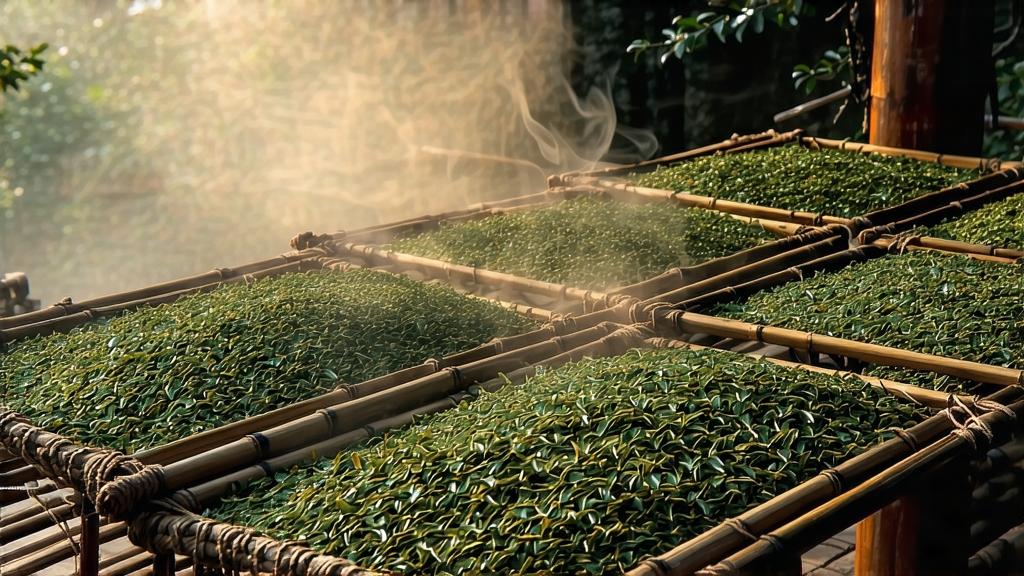
Ask most tea lovers to name a Chinese black tea and they will answer “Keemun” or “Yunnan Gold.” Few realize that both descend from a tiny, rugged corner of northern Fujian where, four centuries ago, a desperate farmer rescued his late-plucked leaves with a pine fire and accidentally created the world’s first fully oxidized tea—Lapsang Souchong. Today the name evokes everything from campfire romance to whisky-barrel cocktails, yet its true story is richer, subtler, and still unfolding in the granite gorges of the Wuyi Mountains.
-
Geography and myth
The original production zone is a 15-kilometre radius around Tongmu Guan, an impossibly steep pass once guarded by Ming-dynasty soldiers. At 1,200 m above sea level, morning fog lingers until noon, filtering UV light and forcing the tea bush to manufacture extra linalool and geraniol—volatile compounds that later translate into honeyed peach notes beneath the smoke. Local legend claims the pass was named “Souchong” because only the smallest sprout (“xiao zhong”) could be carried out alive by the swifts that nested in the cliffs. Travelers prefer the more prosaic explanation: “souchong” simply distinguished the fine, single-leaf grade from larger “bohea” leaves sold to Dutch traders. -
From green to black: an accident that launched a fleet
In 1610 a Qing army unit commandeered Tongmu’s drying barns, delaying the spring harvest. When the farmers returned, their leaves had wilted and begun to oxidize. Rather than discard the crop, they rushed the process, firing the leaves over masson-pine in an effort to halt further spoilage. The result was a glossy, coal-black leaf that emitted an intoxicating resinous aroma. Packed in lead-lined chests, it sailed from the port of Xiamen to Batavia, then onward to Amsterdam, where it fetched ten times the price of green tea. By 1640 “bohea” (a corruption of “Wuyi”) had become a European household word; Samuel Pepys wrote of drinking “a cup of tee, a China drink, newly come to England,” and the East India Company began chartering ships specifically to carry Fujian’s smoky novelty. -
Varieties: a family tree in four branches
Modern commerce lumps everything from Tongmu under “Lapsang Souchong,” but connoisseurs recognize four distinct styles:
a. Traditional Pine-Smoked (Zheng Shan Xiao Zhong)
Crafted only inside Tongmu, using resin-rich masson-pine roots that have aged three years. The leaf is withered over cool embers, rolled, oxidized 80 %, then smoked in three cycles: “wet smoke” at 70 °C to fix the leaf, “dry smoke” at 50 °C to perfume it, and a final “cold smoke” while the tea rests in earthen jars. The finished aroma is reminiscent of lapsang whisky—sweet tar, longan, and dried rose.
b. Unsmoked (Wu Xun Zheng Shan Xiao Zhong)
Developed in 2005 for the domestic market, this version omits the pine stage altogether, relying instead on long withering (18 h) and precise oxidation to coax natural notes of lychee, malt, and cacao. It has become the darling of specialty cafés from Melbourne to Oslo.
c. Wild Arbor Souchong
Picked from feral tea trees (Camellia sinensis var. sinensis) rooted in cliffside crevices. Because the leaves are smaller and higher in polyphenols, they withstand heavier smoking without turning acrid, yielding a cup that tastes of pine honey, wintergreen, and grilled apricot.
d. Aged Souchong
Vintage lots are re-smoked every five years, then sealed in clay jars. After fifteen years the smoke recedes into a backdrop of incense and truffle, while the tea develops a velvety texture prized in Guangdong tea houses.
- Craft: a day in the life of a Tongmu master
The process begins at 3 a.m. when humidity peaks. Leaves are plucked as one bud plus two leaves, ideally from the Jiukeng cultivar whose crenellated margins trap aromatic resins. They